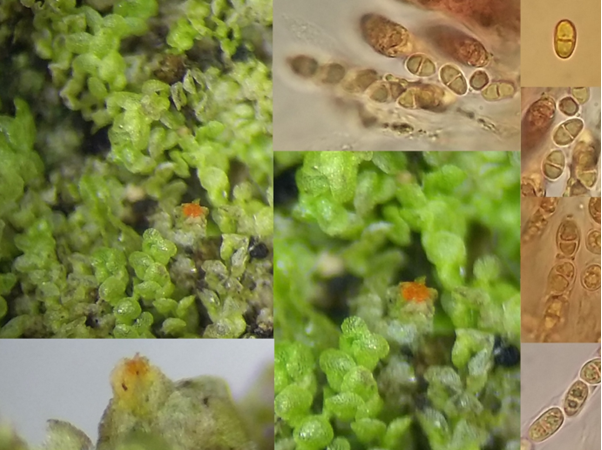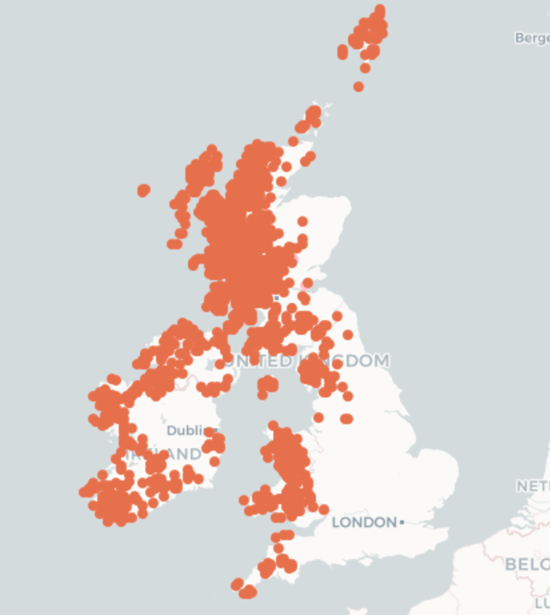Written by George R. L. Greiff, winner of the NBN Newcomer Award in 2018.
The first time I encountered fragments of the special, threatened Atlantic rainforest that occurs in western Britain and Ireland was on the British Bryological Society’s 2018 summer field meeting on the Isle of Arran in Scotland. Although we visited a variety of habitats at the time, I had never seen anything quite like the abundance of mosses and liverworts clinging to trees and rocks in Glenashdale Wood. A series of waterfalls, including the largest, Glenashdale Falls, whips up mist that ramps up the humidity of the woodland along the river. Leafy liverworts grow in great abundance on tree limbs and boulders beside the river, including swathes of Frullania tamarisci and Lejeunea patens. The former is so rare in my home county of the Isle of Wight in south England that it is exciting to find even a tiny patch on an excursion, with plants largely restricted to ancient woodland. L. patens is completely unknown there, confined to more oceanic climates than the Isle of Wight can provide.
A relatively inexperienced bryologist, I was overwhelmed by the diversity of new species on Arran not found in south England. Even species I knew were often so luxuriant that I failed to recognise them. I tried to cling to some form of familiarity: looking for bryophilous fungi on epiphytic liverworts.

Since I started with bryophytes in 2015, the literature gave the immediate impression that bryophytes were resistant to microbial, including fungal, infection. I, like many others, was under the impression that bryophytes must have unique and interesting biochemical mechanisms to protect themselves, given the astounding diversity and abundance of fungi. This started to be dispelled when I found my first bryophilous fungus, and was completely unravelled as I started to successfully find more. On the Isle of Wight, I found that it was relatively easy to spot fungal parasites on leafy liverworts on trees, such as Frullania dilatata and Metzgeria furcata – partly because the plants are flattened and also because they can often be observed at around eye-level. An LED-illuminated 15x hand lens became my constant companion for searching for these fungi, with most almost impossible to detect without strong light. A couple of weeks before the Arran meeting, I found the first British record of Bryocentria hypothallina on Metzgeria furcata on the Isle of Wight, along with B. brongniartii, Bryonectria callicarpa, Periantria frullaniae and Pithyella chalaudii on Frullania dilatata – all new for VC10.
Stimulated by these discoveries, I investigated epiphytic bryophytes for fungi in Glenashdale Wood when I had the chance. I very quickly found a population of the bright orange fungus Filicupula suboperculata on Frullania tamarisci. At the time, there were fewer than ten records worldwide, and the collection was used to generate first ever molecular data for the species. In addition to this, I noticed bright orange spots nestled in the apices of the perianths of the leafy liverwort Lejeunea patens. After sending my small collection to world expert Dr Peter Döbbeler, it became clear that this was an undescribed species.
However, my collection was too small for a type (reference) specimen, so I needed to find the fungus again. After a covid-induced hiatus, I returned to Arran in 2022, exactly four years after originally finding the fungus. I found several populations in Glenashdale Wood, where it was not uncommon. In 2023, I found another population in the Brecon Beacons in Wales, in the spray zone of Sgwd Yr Eira Waterfall. This was enough to fully describe and sequence the fungus. In July 2024, Peter Döbbeler and I described Endoantria benetecta as new to science, not only a new species but a new genus of fungi.

However, this only scratches the surface of our understanding of the fungi that interact with bryophytes in the hyper-oceanic forest zones of Britain and Ireland. With one of the best understood bryophyte floras in the world, biological records can be used to target interesting areas for fieldwork to potentially find more records of Endoantria benetecta as well as search other rainforest specialists for other fungi. Only a handful of records of E. benetecta exist. If we consider the distribution of the host, Lejeunea patens, it is likely that the fungus is more common than it appears. The challenge is on to understand our rainforests and protect the special species they hold.
Acknowledgements
Endoantria benetecta (Hypocreales) – a new perianthicolous ascomycete on Lejeunea patens in British temperate rainforests: https://doi.org/10.1127/nova_hedwigia/2024/0964
Rory Whytock who organised the 2018 British Bryological Society meeting on Arran
